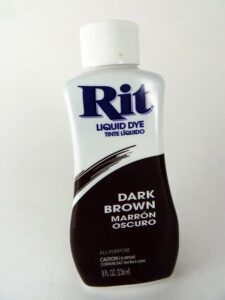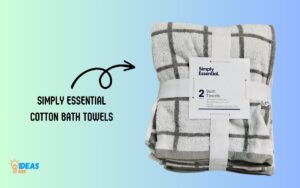How to Make a Hooded Bath Towel? 6 Easy Steps!
Making a hooded bath towel is simple and does not require expert sewing skills. All you need are two towels, one larger and one smaller, a pair of scissors, pins, and a sewing machine.
Start by cutting a square from the corner of the smaller towel. This will serve as the hood. Fold the square in half, pin it together, and sew along the edge.
Next, attach the hood to the larger towel by pinning it to one edge, ensuring that the seams are facing inwards. Sew along the pinned area, and your hooded bath towel is ready.
A hooded bath towel is perfect for keeping you warm and dry, especially after a bath or a swim. They’re also great for children, providing extra comfort and coziness. This DIY project is easy to undertake and offers a practical, stylish, and personalized result.

Key Takeaway
Step-by-Step Guide to Make a Hooded Bath Towel
Step 1: Choose Your Fabric
For the hood and border of the towel, use a coordinating cotton flannel or terrycloth that matches or complements your main towel fabric. Make sure the fabric has nice absorbency and softness.
Step 2: Cut Your Fabric Pieces
- Cut one large rectangle of main towel fabric for the main body. The size depends on if you want a standard, oversized or child’s sized towel.
- Cut two hood/border pieces of your coordinating fabric in the dimensions needed to go around head opening and bottom border.
Step 3: Sew the Hood and Border
- Pin and sew one short end of each coordinating fabric piece to top and bottom of main towel piece, right sides together.
- Fold and press seams. Topstitch edges.
Step 4: Add Casing for Drawstring
At the top edge on each side, fold over again to form casings for the drawstring. Stitch close to folded edge.
Step 5: Insert Drawstring
Use a safety pin to thread cord, ribbon or terrycloth tie through the casings. Knot ends securely.
Step 6: Finish Edges
Zigzag stitch or use an overlock stitch finish on all other raw edges.
There you have it – your own hooded towel! Adjust sizing or dimensions as needed to make child or adult sized.
Factors To Consider When Choosing The Right Towel Material
Learn how to choose the perfect towel material and make your own hooded bath towel with these helpful tips and step-by-step instructions.
Factors
Absorbency and softness:
- Look for materials like cotton or bamboo, which are known for their high absorbency and soft texture.
- These materials will ensure that the towel effectively absorbs moisture from the body and provides a plush feel against the skin.
Durability and long-lasting quality:
- Choose materials that are durable and can withstand frequent use and washing.
- Towels made from high-quality cotton or microfiber are known for their long-lasting durability, making them ideal for everyday use.
Recommended Towel Materials:
Cotton:
- Cotton towels are a popular choice due to their excellent absorbency and softness.
- They are also highly durable and can withstand regular use and washing without losing their quality.
- Egyptian cotton and Turkish cotton are known for their luxurious feel and superior absorbency.
Bamboo:
- Bamboo towels are gaining popularity due to their eco-friendly nature and exceptional absorbency.
- They are naturally antibacterial, making them a great choice for those with sensitive skin.
- Bamboo towels are also known for being soft and gentle on the skin.
Microfiber:
- Microfiber towels are made from synthetic fibers that have a high absorbency rate.
- They are lightweight, quick-drying, and perfect for traveling or sports activities.
- Microfiber towels are also known for their durability and resistance to fading.
Remember, when choosing the right towel material, prioritize qualities such as absorbency, softness, durability, and long-lasting quality.
Selecting a towel made from materials like cotton, bamboo, or microfiber will ensure a comfortable and enjoyable drying experience after a relaxing bath or shower.
Tips for Sewing Success for Making a Hooded Bath Towel
Making a hooded bath towel can be a fun and rewarding sewing project. Here are some tips to help you achieve sewing success:
Materials and Tools:
- Select the Right Fabric: Choose a soft and absorbent fabric like terry cloth or cotton for the towel part. Pick a coordinating or contrasting fabric for the hood.
- Quality Thread: Use a strong, all-purpose thread that matches your fabric.
- Sharp Scissors: Invest in quality fabric scissors to ensure clean and precise cuts.
- Pins or Clips: Use pins or clips to hold fabric layers together during sewing.
- Marking Tools: Fabric markers or chalk can help mark lines and points accurately.
Sewing Techniques:
- Pre-Wash Fabric: Wash and dry your fabric before cutting to account for any shrinkage.
- Accurate Cutting: Take your time to cut the fabric accurately, especially when cutting the hood and towel pieces.
- Stabilize Seams: Reinforce stress points like the hood seam to ensure durability.
- Topstitching: Topstitch around the hood and towel edges for a polished look and added durability.
- Use a Walking Foot: If working with thick or multiple layers of fabric, a walking foot can help feed the layers evenly.
- Adjustable Stitch Length: Use shorter stitches around curves and areas that need extra strength.
- Clip Curves and Corners: Clip curves and corners to help the fabric lay flat and reduce bulk.
- Pressing: Press seams open and press the finished project for a professional appearance.
Troubleshooting:
- Uneven Seams: Check tension settings on your sewing machine. Ensure you are using the correct needle for your fabric.
- Fabric Slippage: Pin or clip fabric layers securely. Consider using a walking foot for more control.
- Bunching Fabric: Make sure your machine is threaded correctly. Adjust the tension settings on your machine.
- Uneven Hems: Measure and mark hems before sewing. Use a ruler or sewing gauge for accuracy.
- Hood Alignment Issues: Mark the center of the hood and towel before attaching. Pin the hood evenly to prevent misalignment.
- Thread Breakage: Check your needle for damage or dullness. Ensure you are using the appropriate needle for your fabric.
- Skipped Stitches: Rethread your machine. Change the needle, as a dull or bent needle can cause skipped stitches.
Remember to take your time, follow the pattern instructions, and practice good sewing habits. Don’t hesitate to troubleshoot issues as they arise, and enjoy the process of creating a cozy hooded bath towel!
Caring For Your Hooded Bath Towel
Discover how to care for your hooded bath towel with these simple tips. Learn how to make your own hooded bath towel and keep it looking fresh and fluffy for years to come.
After you’ve successfully made your own hooded bath towel, it’s important to know how to properly care for it to maintain its quality and ensure its longevity.
Here are some essential tips to keep in mind:
Washing Instructions For Maintaining Quality
- Machine wash the towel using a gentle cycle to protect the fabric and the attached hood.
- Use a mild detergent that is suitable for delicate fabrics. Harsh chemicals can damage the towel and its vibrant colors.
- Avoid using bleach or fabric softeners, as they can weaken the fibers and cause them to become less absorbent over time.
- Wash the towel separately or with similar colors to prevent any color bleeding or transfer.
Recommended Detergent And Temperature
- Use a mild, non-bleach detergent specifically designed for delicate fabrics.
- Opt for a temperature setting of warm or cold water to prevent any shrinkage or damage to the fabric’s fibers.
- Avoid using hot water, as it can cause the colors to fade and the fabric to lose its softness.
Drying Methods And Precautions
- Air drying is the safest method for preserving the towel’s quality. Lay it flat or hang it up to dry naturally.
- If using a dryer, set it to a low heat or delicate cycle to avoid damaging the fabric.
- Remove the towel from the dryer while it’s still slightly damp to prevent over-drying and minimize the risk of shrinking.
Storing And Organizing The Towel
- Fold the hooded bath towel neatly to prevent any wrinkles or creases. This will help maintain its shape and appearance.
- Consider using a designated shelf, drawer, or towel rack to store the towel. This will keep it easily accessible and protected from dust and dirt.
Ideal Storage Conditions
- It’s best to store the towel in a cool and dry location to prevent the growth of mold, mildew, and unpleasant odors.
- Avoid storing it in a damp or humid area, such as a bathroom with poor ventilation, as moisture can damage the fabric and promote mold growth.
Preventing Mildew And Odors
- Allow the towel to completely dry before storing it to prevent any moisture from being trapped.
- If the towel starts to develop a musty smell, machine wash it with a cup of white vinegar or baking soda to eliminate odors.
- Avoid leaving the towel in a wet or damp state for an extended period, as this can lead to mildew growth.
Caring for your hooded bath towel will help ensure that it remains soft, absorbent, and comfortable for your little ones to use after bath time.
By following these simple guidelines, you can extend the lifespan of your handmade towel and enjoy its cozy and functional benefits for years to come.
Conclusion
To wrap up, creating your own hooded bath towel can be a fun and rewarding project, and it doesn’t have to be complicated.
By following the step-by-step instructions outlined in this blog post, you can make a personalized hooded towel for your little one in no time.
Remember to choose a high-quality towel and select a design or fabric that your child will love. Taking the time to measure and cut the fabric accurately will ensure a proper fit for the hood.
Sew carefully and pay attention to details to create a durable towel that will last. Finally, don’t forget to personalize the towel with your child’s name or favorite character to make it extra special.
With these tips in mind, you’ll soon be able to enjoy the satisfaction of seeing your little one snuggled up in a cozy, homemade hooded bath towel. Happy crafting!






